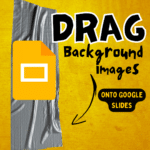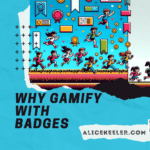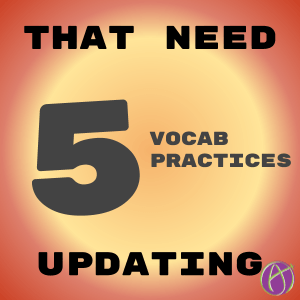
5 Vocab Practices That Need Updating
By Shaelynn Farnsworth and Alice Keeler
It is through language that we learn. Whether reading a novel in English class or studying the digestive system in science; students read, view, listen, and consume content through the comprehension of words. From grades K-12, students learn about 3,000 to 4,000 words a year. Vocabulary is an essential component of all classrooms. With that being said, why do we continue to utilize poor vocabulary practices? It’s time to reexamine how and what is being taught in the area of vocabulary instruction and update the practices that no longer serve our students.
There are 2 important research-grounded assumptions about vocabulary that all educators should be aware of. First, word learning is incremental – not like an on-off switch, instead, it is more like a dimmer switch that keeps strengthening what we know. Meaningful exposures build depth and breadth of our word knowledge. Second, students learn many more words that we can teach them. Vocabulary learning happens incidentally from all types of sources: books, media, conversations, television, social media, and music all contribute to the growing vocabulary of a child (Baker, Simmons, & Kame’enui). Knowing these two things, instruction must be multifaceted and from many angles.
5 Vocabulary Practices that Need Updating
- Word Searches
- Look up Definition, Write a Sentence, Draw a Picture
- Vocabulary Lists of 20+ Random Words
- Give Students Vocabulary List on Monday and Test on Friday
- Teacher Selected Vocabulary Words
“several investigators have dealt with research about what classroom vocabulary instruction is like, and each has concluded that instruction was wanting (Blachowicz & Fischer, 2006; Walsh, 2003). Blachowicz, Fisher, Ogle, and Watt’-Taffe’s (2006) summary about classroom vocabulary practices documents ‘less than robust classroom practice'(p. 524)”
From Beck, I. L., McKeown, M. G., & Kucan, L. (2013). Bringing words to life: Robust vocabulary instruction. Guilford Press.
1. Word Search
Make connections with words rather than make words connect.
The problem with word searches and other similar tasks that mask as vocabulary instruction is what Hattie, Fisher, and Frey designate as students making a “passing acquaintance with a wide range of words,” meaning they lack the cognitive demands and application to actually know a word. Vocabulary instruction must include both depth and transfer; these things are not found in a typical word search. While there are many tasks that could be listed as an alternative here because of their cognitive complexity and authentic use of words in relevant ways to students (Alice’s Meme Template) few methods compare to wide reading by students. When students read more, have a choice in what they read, and engage in the authentic contextualization of vocabulary through discussions and writing vocabulary increases and the transfer happens. Volume matters, if you want to increase student vocabulary, have students read, write, and discuss, (Visible Learning in Literacy.)
Let’s be honest, some students enjoy doing word searches, but let’s not call it quality learning or an assignment. Some students may enjoy making their own word search. Try my Google Sheets Wordsearch template or check out Flippity
2. Look up the Definition, Write a Sentence, and Draw a Picture
“asking students to look up words in the dictionary and use them in a sentence is a sterotypic example of what students find uninteresting in school.” Beck, McKeown, Kucan (2013)
This common practice can be seen in classrooms across the country. I, too, often had students complete this task before digging deeper into evidenced-based practices in vocabulary and word study. And while this method is similar to the Frayer Model, the essential parts of choosing the right vocabulary words to target, as well as focused transfer and application often leads to surface learning of words. Simply copying a word from the dictionary is not enough for depth and transfer. Dictionary definitions are not written for students, they are written succinctly because of space constraints and lack kid-friendly language. Taking a cue from Alice, reimagine the Frayer model by adding small adjustments. Instead of having students use the Frayer Model collaboratively, providing justifications, feedback, etc. Dialogistic learning not only increases engagement through meaningful discussion but also helps student co-construct understanding of vocabulary.
Using Google Slides, peer and teacher feedback is relatively simple. My husband is an English teacher and we have a rule that you’re “not allowed to turn something in without a peer feedback comment on it.” Teaching kids to give high quality feedback results in a critical thinking task for students and an opportunity to have multiple interactions with a concept. My preference is that when responding to feedback to NOT edit their original work but rather duplicate the slide and make updates. Using the template below, after duplicating the slide, the student would click on “Layout” in the toolbar and change the layout to the “Updated.” This shows that the student responded to feedback.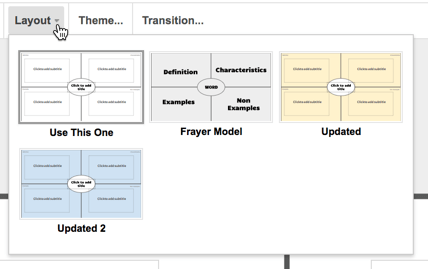
Template
3. Vocabulary Lists of 20+ Random Words
Ineffective vocabulary instruction is often attributed to the wrong words on the “list” instead of the task students do with them. Targeting the right words for vocabulary instruction is often the place that many educators neglect but is the easiest to fix. According to the work of Isabel Beck, educators should focus on Tier 2 words, and at the high school level, a blend between Tier 2 and 3 words. One easy way to determine priority words is “Label or Concept/Topic”. For example, if students were reading The Giver by Lois Lowry, the word “tunic” would be considered a label and one that would be quickly defined by the teacher in the context of the text. On the other hand, the word “Utopia” is conceptual and essential for students to understand to grasps the meaning of the text. It is also a high-frequency word that students will encounter throughout their lifetime and in multiple disciplines and content areas. Intentional focus on Tier 2 words, along with word parts (Morphemes) helps students recognize patterns and make meaning of words based on their suffix, prefix, or base words through analysis. A popular method often seen in the primary grades is through word sorts. Word sorts have students physically manipulate vocabulary based on desired categories. Below is an example created with Google Draw.
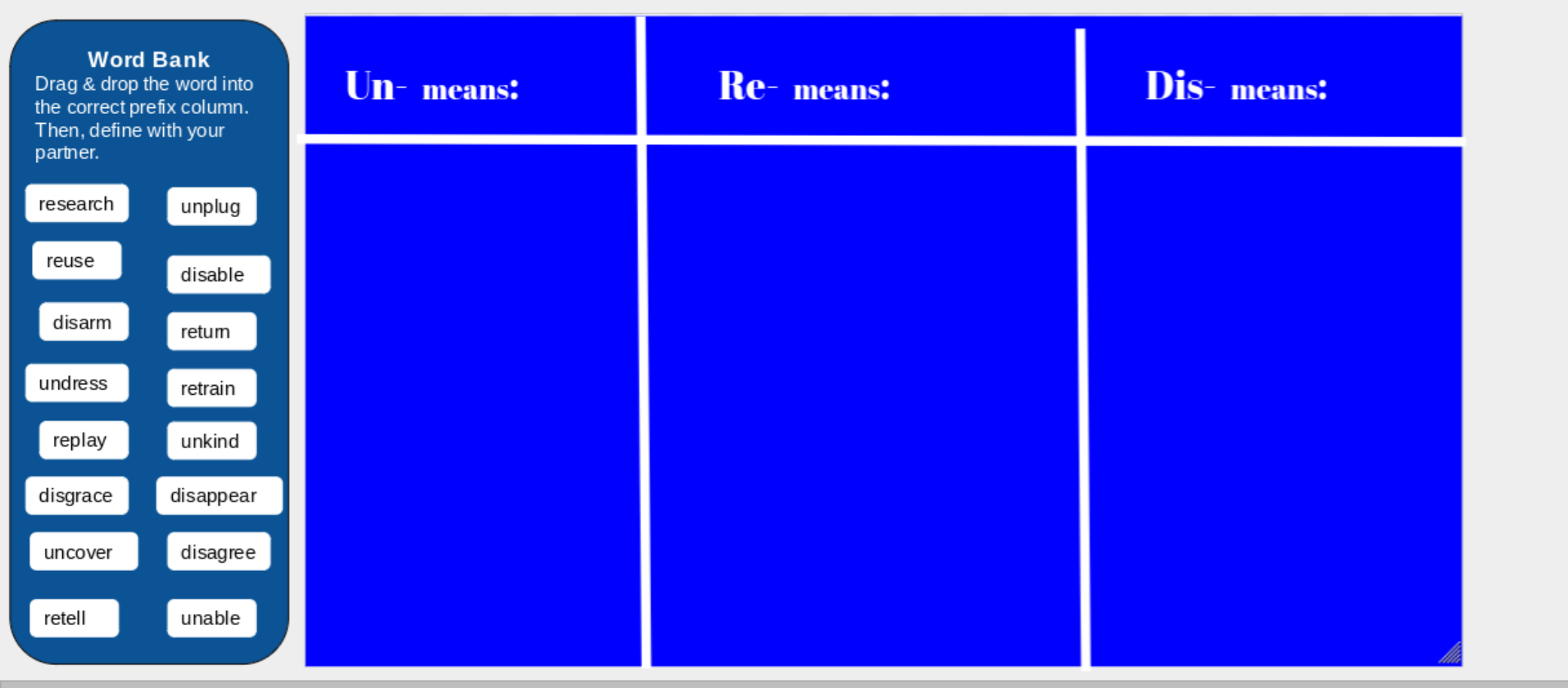
4. Give Students Vocabulary List on Monday and Test on Friday
To truly know a word is dependent upon 3 things: nature of the word, the context in which appears, and the purpose for knowing a word. (Blachowicz, Fisher). There is no magic number of exposures or one task that guarantees the understanding of vocabulary. Vocabulary should be comprehensive and multifaceted. It is through continuous review and authentic discourse in which students consume and create communication employing the focused vocabulary in which both depth and transfer occur. The vocabulary targeted in instruction should not be a one and done. Vocabulary transfer in which students can successfully engage, generalize, and apply their understanding of words is preferred. Students should regularly revisit vocabulary through word walls, through their independent reading and writing, classroom discussions and referenced in direct instruction by the teacher. Check out Shaelynn’s blog post for alternatives for the traditional vocabulary test.
5. Teacher Selected Vocabulary Words
“students need to develop an interest in and awareness of words in order to adequately build their vocabulary repertoires.” Beck, McKeown, Kucan (2013)
In the primary grades, students are unlocking the power of written text; bridging the gap between oral language, sounds, symbols representing those sounds and word meaning. While research suggests that wide reading is one way to increase vocabulary knowledge of students, this claim does not account for those struggling or unmotivated readers who cannot read widely because of decoding issues (Beck, McKeown, and Kucan). Educators cannot rely on students’ independent reading alone to increase vocabulary. Instead, we must foster an environment that encourages all students to be curious about words that are unfamiliar. Rich vocabulary instruction creates enthusiastic learners that recognize word learning outside of their school life is the goal. Along with independent reading, modeling and read-alouds by the teacher, class discussions are extremely important in developing student ownership of vocabulary (Cunningham). A five-minute partner talk, ex. Can an enthusiastic student also be a rebel? to analyze, justify, and support thinking about the meaning of the vocabulary helps to solidify understanding and also encourages student ownership of words. Another activity to consider that would mix both teacher selected vocabulary and student chosen words are concept mapping. In essence, students would generate a list collaboratively of words based on a concept or topic that is being studied. From there, students would map connections between the list of words, discovering meanings of those words that are unfamiliar, as well as justifying why groups of words belong together and how they are connected. This activity not only reinforces word learning, but also collaboration, critical thinking, and is student-centered. Below is an example created with Google Draw. We crowdsourced words and phrases around “Assessment” via Twitter for this example, thank you to everyone who added to the list! Template Here Example of the Crowd-sourced one on Assessment.

A rich vocabulary is not only an essential quality of an educated individual but unlocks content understanding for our students and provides them with future possibilities in life. Vocabulary is learned in the classroom when purposeful reading, writing, listening, and speaking takes place. It is also a part of every discipline and every grade. Educators can maximize student achievement by reexamining their current vocabulary practices and spend 10 to 15 minutes a day using some of the evidenced-based practices listed above.
Links to Articles and Research
2010 A Review of the Current Research on Vocabulary Instruction
Bringing Words to Life, Second Edition: Robust Vocabulary Instruction
The Nature of Vocabulary Acquisition
Best Practice in Literacy Instruction
The Fountas and Pinnell Literacy Continuum
Blog Posts from Rasinski and Shanahan
Links to Shaelynn’s Vocabulary Posts
7 Alternatives to Traditional Vocabulary Tests
Technofy Your Vocabulary Instruction
From the Twittersphere
My practice: describe characters in reading with a new adjective. Curious George is inquisitive. He also meddles.
— Cheri Mann (@itscherij) February 2, 2018
Using vocab (followed by appositives) in content-specific or cross curricular projects students create to show mastery of many standards!
— Marisa Thompson (@MarisaEThompson) February 2, 2018
Loathe: thinking that doing the Freyer model a) is enough to own the words and b) works for all kids. Also writing sentences to learn randomly selected words.
— Cheri Mann (@itscherij) February 2, 2018
I can’t remember if it’s from the same study, but I remember hearing that children have to hear a word used approximately 70 times before it can become a part of their vocabulary.
— Mickey McFetridge (@MickMack629) February 2, 2018
When I taught 7th grade, I had students create stories with the words needing learned.
— Aaron Harris (@HTXTeach) February 2, 2018
Practice & quizzes that look like this. NO context & totally impractical to memorize lists of synonyms & antonyms. pic.twitter.com/Iu6nwtaNX7
— Meghan Johann (@JohannMundy) February 2, 2018
Pretty please no copying definition = doesn’t work @alicekeeler @shfarnsworth https://t.co/eKv9A5GM3p
— Ms Mcmichael (@bluebutterflysm) February 2, 2018
Vocabulary words should be chosen organically, not just from a word bank at the beginning of a chapter.
— Nicole Bisnar (@MrsNBiz) February 2, 2018
Make a big deal about learning tier 2 words that come up in class. Everyday vocabulary most important. Assess those by having Ss use them elsewhere.
— David Hochheiser (@DavidHochheiser) February 2, 2018
Breaking down the word to the root, when applicable, and associating it with other words of the same root. ??
— Rachel Langenhorst (@rlangenhorst) February 2, 2018
Iron Chef Slides – Vocab Edition!@jcorippo @MrPrincipalRock #gvusdshares #goldenvalleyway pic.twitter.com/sQInNu4bnM
— Kevin Feramisco (@theteachingjedi) February 2, 2018
We have Ss create a slide for a specific latin root/prefix/sufrix that connects to current content. By end if yr, Ss have digital collection. pic.twitter.com/Bx2ZUF5K8x
— Karen Conner (@KConner1213) February 3, 2018
I preload all of my units with key terminology. Ss do a self assessment to rank the words 1=don’t know it at all, 2= sort of know it, 3= totally know it. They pick 10 #1 words to research and demonstrate their understanding in a variety of ways (images, def’n, model, explain).
— Aleecia B (@aleeciabrunberg) February 3, 2018
❤️ this: Ss are given a term to discover, plus an image or context passage. Solve an Inference formula {I know that ___ means ___, because… (the context or evidence from an image) AND I already knew (evidence from schema)}. Share out, refine definition with class schema.
— Barbara Goebel (@BGLearns) February 3, 2018
Show examples side-by-side of beginning, developing, and rich descriptive writing. Three samples. Don’t label which is which. Same topic. Interesting story. Get the kids to be curious detectives. 1/2
— Nicole Jarvis (@nico1e) February 3, 2018
2/2 Analyse the three samples in small groups. THEY point out the differences. THEY decide which one is good, great, awesome. THEY describe *why* and *how* – do a brainstorm of awesome. Then THEY write their own – mimic the style but change the topic. Keep examples visible.
— Nicole Jarvis (@nico1e) February 3, 2018
I use my game narrative and give students a redacted document with clues relevant to their game. Gives a fun twist that does include the C’s and they solve this in houses.
— Kate Hodges (@_Katehodges) February 3, 2018





